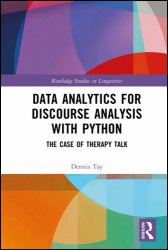Data Analytics for Discourse Analysis with Python: The Case of Therapy Talk
- Добавил: literator
- Дата: 25-02-2024, 16:05
- Комментариев: 0
 Название: Data Analytics for Discourse Analysis with Python: The Case of Therapy Talk
Название: Data Analytics for Discourse Analysis with Python: The Case of Therapy TalkАвтор: Dennis Tay
Издательство: Routledge
Год: 2024
Страниц: 190
Язык: английский
Формат: pdf (true)
Размер: 16.5 MB
This concise volume, using examples of psychotherapy talk, showcases the potential applications of data analytics for advancing discourse research and other related disciplines.
The book provides a brief primer on data analytics, defined as the science of analyzing raw data to reveal new insights and support decision making. Currently underutilized in discourse research, Tay draws on the case of psychotherapy talk, in which clients’ concerns are worked through via verbal interaction with therapists, to demonstrate how data analytics can address both practical and theoretical concerns. The Python code used to implement examples in the conceptual walkthroughs and case studies will be presented as they are discussed, for readers to try them out as they go along. The various code snippets throughout will be presented again at the end of each chapter to provide a bird’s-eye view of the logical flow of the techniques and their components. All code and data files are also available upon request and stored on my GitHub site. The numerical representation of different aspects of texts to facilitate subsequent quantitative analysis is a basic task in fields like corpus linguistics and natural language processing (NLP).
Somewhat related but perhaps less familiar to discourse researchers is the fundamental computational linguistic process of word embedding. This refers to various techniques to map language-in-context to numerical vectors that represent their semantic and syntactic properties, to facilitate subsequent tasks like language modeling, part-of-speech tagging, named entity recognition, sentiment analysis, machine translation, and so on. These increasingly sophisticated techniques underpin state-of-the-art large language models like Google’s Word2Vec, BERT and, more famously, OpenAI’s GPT.
A programming language can be described as a closed set of vocabulary and grammatical rules for instructing a computer to perform tasks. Python is acknowledged by many sources as one of the most popular and fastest growing programming languages in the data science industry, and this is the main reason for choosing it to implement the techniques in this book. Real-world contexts where Python is used include web and software development, AI and Machine Learning, finance, image processing, operating systems, statistical analysis, and many more.
Python is recognized as a high-level, general-purpose programming language. This means it resembles human language more than machine code, has multiple uses, and works across operating systems. We can contrast it with low-level languages like C where the vocabulary and grammar are unintuitive to humans but more directly ‘understood’ by computers, and domain-specific languages like SQL and MATLAB, which are designed to solve particular kinds of problems. Implementing data analytic techniques is just one of Python’s many uses. While it would do an excellent job for the present and other conceivable discourse analytic purposes, we should bear in mind that Python is by no means the only way to implement the techniques discussed in this book.
Python libraries refer to pre-written collections of code, or modules, that are available for use once they are ‘imported’. Each library is typically designed to perform a key task or coherent group of tasks. Many libraries, including the ones used in this book, come with a standard Python installation, but more specialized ones may need to be installed by the user. We will be consistently using the following key libraries – Pandas (for data management); Matplotlib and Seaborn (for data visualization); and NumPy, Scikit-learn, and statsmodels (for statistics and data analytics).
The volume shows how techniques such as simulations, classification, clustering, and time series analysis can address such issues as incomplete data transcripts, therapist–client (a)synchrony, and client prognosis, offering inspiration for research, training, and practitioner self-reflection in psychotherapy and other discourse contexts.
This volume is a valuable resource for discourse and linguistics researchers, particularly for those interested in complementary approaches to qualitative methods, as well as active practitioners.
Скачать Data Analytics for Discourse Analysis with Python: The Case of Therapy Talk
[related-news] [/related-news]
Внимание
Уважаемый посетитель, Вы зашли на сайт как незарегистрированный пользователь.
Мы рекомендуем Вам зарегистрироваться либо войти на сайт под своим именем.
Уважаемый посетитель, Вы зашли на сайт как незарегистрированный пользователь.
Мы рекомендуем Вам зарегистрироваться либо войти на сайт под своим именем.
